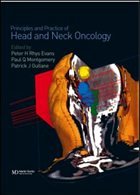Table of contents:
I Basic Principles of Management 1. Introduction 2. Molecular biology 3. Imaging in head and neck cancer 4. Principles of head and neck radiotherapy 5. Chemotherapy for head and neck cancer 6. Anaesthesia for head and neck tumour surgery 7. Nursing care of head and neck cancer patients 8. Nutritional support of head and neck cancer patients 9. Dental management of the head and neck cancer patient 10. Palliation of advanced head and neck cancer II Mainly Squamous Neoplasms 11. Tumours of the oral cavity 12. Tumours of the nasopharynx 13. Tumours of the oropharynx 14. Tumours of the hypopharynx 15. Tumours of the larynx 16. Management of the neck III Mainly Non-Squamous Neoplasms 17. Tumours of the upper jaw and anterior skull base 18. Management of tumours of the temporal bone 19. Tumours of the parapharyngeal space 20. Salivary gland neoplasms 21. Cancer of the thyroid gland 22. Tumours of the parathyroid glands 23. Cutaneous melanoma of the head and neck 24. Sarcomas of the head and neck 25. Juvenile angiofibroma IV Rehabilitation and Reconstruction 26. Complications in head and neck cancer surgery 27. Principles of head and neck reconstruction following cancer surgery 28. Reconstruction of the oral cavity and oropharynx 29. Reconstruction of the ear 30. Principles of nasal reconstruction 31. Functional restoration of speech 32. Future developments in head and neck cancer therapy
‘Principles and Practice of Head and Neck Oncology’ takes a multidisciplinary approach which reviews all aspects of the management of head and neck cancer from initial diagnostic procedures, through staging, surgery, radiation and chemotherapy to aftercare and rehabilitation. It includes conditions affecting both adults and children, and is one that affects a variety of organs and structures. The first section introduces the reader to the multidisciplinary nature of managing this very diverse group of diseases, and the means by which they are treated. Topics covered include the molecular biology of these tumours, applications of chemotherapy and broader issues of nursing care such as nutrition and dental hygiene. Sections 2 and 3 review each of the major types of cancer: Section 2 is dedicated to tumours of the upper airways and digestive tract, including the mouth, nasopharynx and larynx, while Section 3 covers the rest of the head and neck and organs therein, including the skull base tumours, thyroid and salivary glands. There has been a change in approach and a move towards a more holistic approach taking greater acount of quality-of-life issues. There is increased use of conservation laser and other surgical techniques as well as chemo-radiotherapeutic regimes. The combined experience of the editors and contributors gives a broad and balanced view of current approaches.
This text takes a multidisciplinary approach which reviews all aspects of the management of head and neck cancer from initial diagnostic procedures, through staging, surgery, radiation and chemotherapy to aftercare and rehabilitation.
I Basic Principles of Management 1. Introduction 2. Molecular biology 3. Imaging in head and neck cancer 4. Principles of head and neck radiotherapy 5. Chemotherapy for head and neck cancer 6. Anaesthesia for head and neck tumour surgery 7. Nursing care of head and neck cancer patients 8. Nutritional support of head and neck cancer patients 9. Dental management of the head and neck cancer patient 10. Palliation of advanced head and neck cancer II Mainly Squamous Neoplasms 11. Tumours of the oral cavity 12. Tumours of the nasopharynx 13. Tumours of the oropharynx 14. Tumours of the hypopharynx 15. Tumours of the larynx 16. Management of the neck III Mainly Non-Squamous Neoplasms 17. Tumours of the upper jaw and anterior skull base 18. Management of tumours of the temporal bone 19. Tumours of the parapharyngeal space 20. Salivary gland neoplasms 21. Cancer of the thyroid gland 22. Tumours of the parathyroid glands 23. Cutaneous melanoma of the head and neck 24. Sarcomas of the head and neck 25. Juvenile angiofibroma IV Rehabilitation and Reconstruction 26. Complications in head and neck cancer surgery 27. Principles of head and neck reconstruction following cancer surgery 28. Reconstruction of the oral cavity and oropharynx 29. Reconstruction of the ear 30. Principles of nasal reconstruction 31. Functional restoration of speech 32. Future developments in head and neck cancer therapy
‘Principles and Practice of Head and Neck Oncology’ takes a multidisciplinary approach which reviews all aspects of the management of head and neck cancer from initial diagnostic procedures, through staging, surgery, radiation and chemotherapy to aftercare and rehabilitation. It includes conditions affecting both adults and children, and is one that affects a variety of organs and structures. The first section introduces the reader to the multidisciplinary nature of managing this very diverse group of diseases, and the means by which they are treated. Topics covered include the molecular biology of these tumours, applications of chemotherapy and broader issues of nursing care such as nutrition and dental hygiene. Sections 2 and 3 review each of the major types of cancer: Section 2 is dedicated to tumours of the upper airways and digestive tract, including the mouth, nasopharynx and larynx, while Section 3 covers the rest of the head and neck and organs therein, including the skull base tumours, thyroid and salivary glands. There has been a change in approach and a move towards a more holistic approach taking greater acount of quality-of-life issues. There is increased use of conservation laser and other surgical techniques as well as chemo-radiotherapeutic regimes. The combined experience of the editors and contributors gives a broad and balanced view of current approaches.
This text takes a multidisciplinary approach which reviews all aspects of the management of head and neck cancer from initial diagnostic procedures, through staging, surgery, radiation and chemotherapy to aftercare and rehabilitation.

